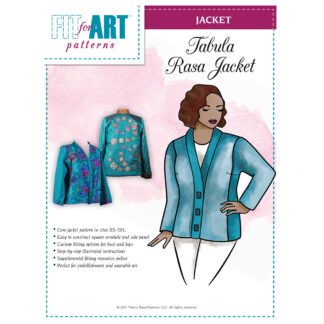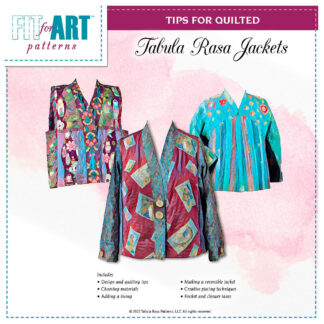
Welcome to Sew! Let’s Get Dressed, a weekly blog that encourages you to sew successfully.
Recently we received a sample card from one of our wholesale fabric sources for a very light weight polyester with moisture wicking and UV protection. Not our usual purchase, but I am getting ready for a journey to a very hot place with strong sun and thought it would be fun to try making my own “travel clothes” – REI style. I ordered a couple of yards in a few colors to test and made a pair of elastic waist capris and a short sleeve shirt for my trip.

I knew I could use my pattern for the TRJ Shirt Variation with short sleeves, like the camp shirt I wrote about last year, but I didn’t want to have facings flapping around and adding weight. I decided to try a self-facing technique I’d seen in another shirt pattern when I was taking a workshop a few years ago. With this technique, you extend the center front and fold it under twice to achieve a finished edge. So, I traced off my shirt front pattern and added another inch to the center front by laying my ruler along the center front cutting line and drawing a new line 1 inch away. I cut out the pattern but left extra paper at the neckline; after folding the center front in at 7/8” and again at 1”, I finished cutting the neckline. This is the how my front pattern looks.

The challenging aspect of this project, at least for me, was figuring out how to finish the neckline into the collar without a facing to cover it. With the advice of my dear friend and colleague (Rae of course!), this is what I ended up doing. I constructed the spread collar as usual, planning for its finished length to end 5/8” in from the what would be the finished center front. After basting the collar onto the neckline, I added a bias strip (folded in half the long way with and pressed WST) on top of the collar and securely stitched all layers together.


To finish the center front, I turned the front extension in by 7/8” and again by 1”, pressing in the two folds to form a self facing. Then, I reversed the second fold, turning the self-facing so the right sides were together and stitched along the 5/8” neck seam. After trimming all the seam allowances, I turned the self facing to the inside. I folded the bias binding down to cover the seam allowances around the neck. This produced a nice clean finish along the neckline, but I am not entirely happy with how the bias strip shows at the top of the shirt when the collar is open. Next time I think I’ll try folding the bias strip down before turning the self-facing to the inside to hide the end of the binding.

I finished the center front at the hem in way a similar way to the kimono band of the Tabula Rasa Jacket. I pressed up the hem (using two 1″ folds to add weight to the hem). Before securing the hem, I turned the self-facing to the outside, just like I did at the neckline, and stitched along the hem fold. Then I turned the hem up and self-facing in all in one step to create a smooth finish that hides all raw edges. Because of the double fold, I did have to clip a good bit of excess fabric out of the hem to allow it to lay smoothly. This being a shirt that will get some rough wear and washing, I used a machine blind hem stitch to secure the hem between the front facings.


I finished my shirt front with two rows of topstitching, one 1/8” in from the finished edge and the other 7/8” in. This secured the self-facing and confers an authentic shirt look. I carried the topstitching around the collar to secure the bias binding as well, again because this very practical shirt doesn’t require hand stitching.

I chose decorative snaps for the front closure. Here are the very basic tools used to apply the snaps – both the snaps and the little device to assist with hammering were purchased from a JoAnn’s craft store.

The capris were created from my basic Eureka! Pants that Fit pattern following the elastic waist directions. I figure an elastic waist will be great for travel when I eat too much yummy food! I wanted pockets but was afraid that back patch pockets wouldn’t cut it with such light fabric. (Wouldn’t it look great to have one side of my rear sagging from the weight of a phone?) Instead I added the front slash pockets from my Trouser Details pattern. For a little visual detail, I cuffed the hem of both the pants and the shirt sleeves.

Voila, I am ready to travel. I really like the soft hand and weight of this fabric — it’s so light it will fold up into next to nothing — but I will have to report on its performance after I get home!
What are you sewing to wear in hot summer weather, whether it be at home or on the road?
Happy Sewing! Carrie
Enjoy receiving our blog? Sharing is caring, so forward this post to a friend by clicking on the Forward link at the upper right corner of your e-mail notification. Remember that the beauty of the Fit for Art System is you can sew successfully with endless variations. Take a moment to review our variation patterns by clicking here. Also, are you following us on social media? Take a moment to check us out on Facebook and Instagram and follow the hashtag #fitforartpatterns and #sewsuccessfully.







Where can I buy the shirt fabric? I’ve been looking for moisture wicking and UV protection fabric.
Thank you for the beautiful photos of your process. Where do I get that fabric please. It sounds and looks like something I need. Happy Traveling.
If the poly fabric works in hot weather, let me know if you will be selling it.
The fabric came from one of our wholesale suppliers. I’d like to check out how it performs before I recommend it. If I’m happy with it, we will certainly consider selling it. Glad to know you are all interested!
I am looking forward to your review of this fabric. I’m making tops for a European trip and the temperature will vary widely. So far I have performance knots in my stash. This looks like a woven
Yes Donna, it is a woven and I believe it is getting a good workout in India right now!
Hi Rae and Carrie, I wanted to let you know that I am enjoying all of your blogs. I actually print them out and keeping them in a binder for future reference. I am not sewing as much as I would like but I’m getting a little done. I’m hoping to see you at the EXPO in Fredricksburg in September. In the meantime, have a great summer and great travels.
So nice to hear from you Glenda! Please do come by in Fredericksburg, and bring some Tabula Rasas to share!